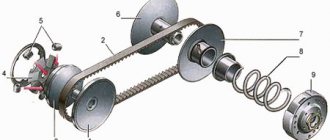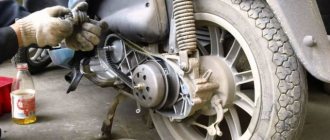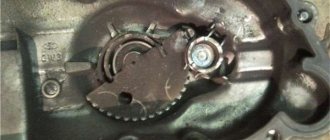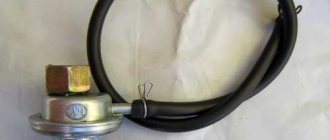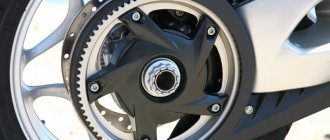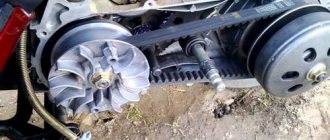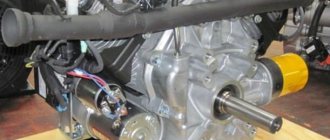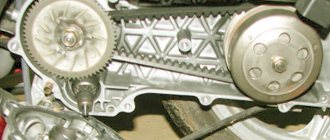What happens if you install a variator belt of a different size?
Sometimes, for various reasons: lack of availability of the required variator belt;
a desire to save money or just for the sake of experimentation - there may be a need to install a variator belt that differs in size from the original part. Whether the belt is longer or shorter, wider or narrower, in any case there will be consequences. But we’ll try to figure out below what consequences await when installing a variator belt of a different size! Ps: If you don’t want or don’t have time to read the entire article, go straight to the table.
What happens if you put a longer variator belt?
When installing a longer variator belt, the equipment will lose dynamics, the maximum speed and fuel consumption may increase, and there will be a slight increase in torque. Since at idle and maximum speed the variator belt can protrude beyond the edges of the pulleys, there is a risk of damage to the belt and the variator housing. Also, when installing a variator belt that is too long, in addition to the consequences described above, at idle and maximum speed it may protrude too far beyond the boundaries of the pulleys and jump off (fall out).
What happens if you install a thick variator belt?
Installing a thick variator belt will lead to the following consequences: the belt will cling to the drive pulley bushing at idle speed and to the driven pulley bushing at maximum speed; the response time of the variator to the throttle trigger will increase and the dynamics will worsen (it will be more difficult for the pulleys to “push out” a thicker belt); The maximum speed will decrease because the belt will not reach the required radius. The pulley-belt contact patch will increase, which will lead to a decrease in the slippage of the variator belt.
How to choose a belt on a scooter?
Unlike conventional mopeds, instead of a chain, the scooter rides with a special belt, so the movement of the scooter and its driving characteristics are very different. Unfortunately, the belt on a scooter often needs to be replaced, because it is a consumable item. The belt will have to be changed if its wear is more than 1 mm from the permissible norm. The procedure for replacing a belt is quite simple and can be done without the help of specialists. But the main difficulty is how to choose a variator belt on a scooter.
Depending on the scooter model, there are different belts; they are classified by size and marking. If you don’t want to worry about the right size, we recommend asking the seller; experienced sellers can select the right size according to the scooter model. But there are cases when it is difficult to determine the size and marking of the belt based on the model, so you will have to ask for a special size table.
It should be in the instructions for your scooter, you can also find the full specifications of your scooter, where the belt size will be written. Please note that in most cases you will have to look at the engine manufacturer, often it is taken from one well-known manufacturer as the basis for a new model. This problem may arise when selecting a belt for a Chinese scooter, because they always steal engines from more well-known brands. Japanese-made scooters such as Yamaha Jog, Honda Dio, Suzuki Sepia and others have an original design and, accordingly, it will be much easier to find a belt on them.
What is the optimal weight for rollers?
And so, let’s repeat the principle of operation of rollers for a scooter’s variator. When the crankshaft rotates, the rollers diverge by a certain amount. The higher the speed of the power unit and the rotation of the crankshaft, the greater this value. This means the belt extends more and the scooter starts faster. The two-stroke power unit on a scooter is characterized by operating at maximum speed. For the most part, scooter rollers cope with this task.
Quite heavy rollers accompany belt extension at low speeds. At the same time, a drop in dynamics is observed. But, at the same time, the maximum speed is achieved. The operating principle of light rollers is the opposite. That is, the productive element works to its maximum in order to gain maximum speed. Dynamic qualities are reduced back. At the start, the speed will increase quite quickly, but up to 30 km/h. After that, it will be more and more difficult to gain speed.
Based on this, we can draw the following conclusion. The weight of the rollers should be average, optimal. It should be borne in mind that the speed of a moped does not always depend on the weight of the rollers. A significant influence is exerted by the current drive spring - a large spring that is located behind the clutch. What is it for? - responsible for belt fatigue and tension. When it is weakened, the belt is ejected to a larger radius. Thus, with normal weight of the rollers, it is difficult to reach the maximum speed. Often, in such situations, the spring is replaced.
First you need to try rollers half a gram lighter than indicated in the instructions. Experienced scooter riders always have rollers of various weights in “steps” of 0.5-1 grams. The optimal rollers are determined by trial and error. It is difficult and practically impossible to indicate which rollers to install on a scooter without “experiments”. After all, each scooter may have a different condition of the CPG, belt and spring, and variator. One thing can be said for sure, without any doubt: it is impossible to install rollers of different weights in one set. This leads to an imbalance in the operation of the crankshaft and the rapid replacement of its bearings.
How to choose a belt on a scooter
If it is impossible to choose the size, you will have to do everything “by eye”. It is enough to bring the damaged belt and try to compare its dimensions with the new belt. If possible, you can find the markings and size on the old belt, this will simplify the selection process. Sometimes the “poke” method is used. We will not provide tables of all scooter models, because this is practically unrealistic, but we will only give an example by presenting a table of matching belts for the Honda Dio Af-27 scooter.
Health to all and forever!
Sednya wanted to buy a belt for his 139QMB, but left the magician with nothing. Because I did not agree with the dimensions of the “standard” belt 669x18x30.
"Mototech" was suggested. It turned out to be 13mm longer (I agreed with this) and narrower - 17.5mm (and I can’t get one like that). The seller tried to convince me that the belt does not stretch, because... The cord mesh of the belt will not allow this, and I cannot find the exact width, 18mm. To which I retorted: “What the hell are the inscriptions on the belt and why does the Chinese quality control department receive a salary and the purpose of such a belt - in the absence of any, how to get there, if anything.” And I'm harmful! The transmission pulleys are definitely made of metal, which means the belt should be. to the neck.
Guys, whose side are you on? Mine or the seller's? And the main question is: who has experience buying belts? Is it really possible to buy a STANDARD belt with the appropriate dimensions, at least in width? (Recently the width size is indicated not just 18, but 18.1 - what is that?) Or - I just can’t find it?
I have a belt 669x18x30, some kind of endurance, I’ve done nothing on it. I bought it out of curiosity to try it, but it’s not 18 wide, but 17.7. Why can’t you just find the belt?
Added (06/27/2015, 06:13)
—————
well, 13mm is a lot, although the belt needs to be measured, sometimes they write this on them
Yeah! With a belt, like with shoes at our bazaar, without looking at the size: - “You have to try it on.”
slaviks,
The length of the belt that is most suitable for your scooter can be selected as follows: take a cord or rope, apply one end to the variator bushing and, holding it with the other hand, pull it towards the clutch and trace the lace along the upper edge of the clutch cheek (in a circle), then pull it back to the variator and trace it around the bushing to the end of the rope, mark or cut off the length, measure with a tape measure - here is the length for your specific case, the width of the belt is equal to the distance from the inner cheek of the variator to the mating cheek along the bushing, but in practice it is better to measure from the inner cheek to the mating cheek with the cheeks brought together at the top, at the edges.
I measured the length of the ENDURANCE, the size is almost the same: 666mm, only 3mm, so you can take it if you find it, well, there is definitely one in Kharkov, it’s a Honda size, well, for a 139 engine
CVT device on a scooter
A variator is a modern gearbox device, and its use in various vehicles is gaining popularity every day. The mechanism of the CVT gearbox on scooters is very simple: its developers were based on the action of centrifugal force, which made the design lightweight.
CVT components
The scooter has a small weight and dimensions (compared to motorcycles and cars), respectively, and the gearbox should be small.
From the automobile, the scooter's variator inherited:
- two pulleys - driving and driven (although here they are wedge-shaped, and each consists of two halves);
- belt (its shape is trapezoidal, unlike a car belt).
That's all the legacy.
The position of the wedge-shaped halves (cheeks) of the drive pulley is regulated by rollers. The opening and closing of the driven pulley cheeks is carried out by a central spring connected to the clutch.
More about the operating principle
So... The scooter is started and idling. What happens in the variator? The drive pulley rotates at minimum speed. The strap is located just above the center of the cheeks. The slave's cheeks are compressed by a central spring. The belt on them moves along the maximum radius.
The scooter started moving. It's worth mentioning the videos here. They are located behind the inner cheek of the drive pulley. When the speed of rotation of this pulley increases, centrifugal force pushes the rollers towards the outer radius, thereby pressing the halves of the drive pulley together. The belt between these halves moves outward - the radius of its rotation on the leading cheeks increases.
The driven pulley acts exactly the opposite. During acceleration, a centrifugal force acts on it, just like on the rollers, with the help of which the cheeks move apart, compressing the central spring and passing the belt between them. This is how acceleration happens.
Due to this synchronous operation of the pulleys, speed increases at constant speed and maximum engine power.
Setting up a variator on a scooter
By adjusting the variator, the desired dynamics of the scooter are achieved. It can be improved by replacing both the factory rollers and the spring.
The operation of the rollers on a scooter's variator depends on their weight. The manufacturer selects the optimal one when assembling the box. But those who like to drive fast change them to heavier ones. With weighted rollers, a scooter with a variator accelerates more slowly at the start, but after reaching maximum speed, the engine produces a speed 10-15 km/h higher than with factory rollers.
Using rollers of less weight leads to the opposite principle: the scooter starts sharply, but it is difficult for it to reach maximum speed.
Changing spring stiffness also affects speed. Stretched and weak, it will not be able to tightly press the cheeks of the driven pulley. This will cause the belt to constantly operate at a smaller radius than necessary. A spring that is too stiff, on the contrary, will not allow you to reduce this radius (correspondingly increase the speed of the driven pulley) and develop the maximum speed of the scooter.
Repair of a variator on a scooter. Replacing elements
A change in acceleration speed and the appearance of extraneous noise in the variator indicate that some part (or parts) are worn out and require replacement.
To find out the cause of the malfunction, you should disassemble the variator:
- Remove the cover. We do this carefully so as not to damage it. As a rule, the variator cover on scooters has a sealing gasket. It is necessary to evaluate its condition and, if necessary, change it.
- To remove the belt from the variator, you need to remove the drive pulley. And you can get to it only by removing the retaining ring, clutch and gear.
- When the belt and pulley halves are ready, remove the rollers.
- All items must be carefully inspected and tested. Serviceable cheeks have a smooth surface without chips or burrs. The presence of any lubricants on the belt is excluded. If it looks shabby, then it's time to change it.
- After identifying faults, we assemble the variator in the reverse order.
There are two main signs by which the quality of the variator is determined: belt movement and engine speed. In a working variator, the belt does not slip in the pulleys. But, if the engine roars and the scooter does not move, this is the first signal that it is time to look inside the device and examine the condition of the belt and spring.
The operating speed of the engine must correspond to the speed of its maximum power. If this does not happen, it’s time to start adjusting the operation of the variator.
Choosing the right variator belt
Choosing the right variator belt
Post by Emil » Jun 12, 2022, 9:35 pm
Re: Choosing the right variator belt
Post by Sylver » 13 Jun 2022, 09:10
Maybe the belt is just too long to begin with?
Or completely Chinese?
Maybe the torque jams and it doesn’t tension the belt when you let off the gas?
Regarding belts: the best one is Bando, but you can’t buy it here, they only come with new equipment, at least I’ve never seen them on sale. From what we have, take Gates Power, but you also need to take it wisely, so as not to run into a fake, and it’s better with a blue thread, they worked best for me. I can recommend taking it from Moto-Scooter - I’ve never had any complaints about them. And the guy from my motodart didn’t even go 200 km.
PS: Malossi Kevlar is also good, but the price tag is high and you need to take the Malossi variator in the kit, otherwise the strap will very quickly eat up your variator.
Variable speed belts for agricultural machines.
The paragraph provides data on belts in accordance with GOST 25379-84, widely used in agricultural machines. By agreement between the manufacturer and the consumer, belts are manufactured with molded or cut teeth and without teeth.
Belts with teeth at a wedge angle of 26° and low power make it possible to obtain an adjustment range of D = 3.5 for symmetrical regulation. In the case of medium-power CVTs under the same conditions, the regulation range is about 2.6. For high-power variators, belts without teeth are used, in which case the adjustment range is reduced to 2.
how to choose the right variator belt?
As you know, a fairly large number of Chinese motorcycles, be it a scooter or a snowmobile, are equipped with an automatic transmission with a V-belt variator.
Like any node, it has a weak point. As a rule, this is a variator belt, which sooner or later becomes unusable and must be replaced. It is worth noting that according to the regulations, the belt must be changed every 20,000 km. But don’t think that you shouldn’t look under the variator cover before passing this mark. In addition, if you purchased equipment that is no longer new and how the previous owner treated it, it is difficult to find out at first glance. Therefore, do not be lazy and check the condition of the belt at least before the start of the season, thereby in the future you will save not only wasted time, but also a significant amount of money. So, how can you determine whether it’s time to change the variator belt or whether you can still drive? First, you need to carefully inspect the belt by bending and unbending it. There should be no cracks or tears on it. Secondly, measure the width of the belt
VERY IMPORTANT! The width of the belt must be measured at different points as wear may occur unevenly. Minimum permissible wear 1-1.5 mm depending on the manufacturer
If you still need to replace the belt, be sure to pay attention to its markings (see figure below)
1 - belt length; 2 — belt width; 3 - belt tooth length.
If you cannot read the markings, then take the appropriate measurements and inform the seller so that he can select a similar variator belt.
Installation Tips
Your snowmobile's CVT belt is an integral part of the drive system and can have a significant impact on the behavior and feel of your snowmobile. The variable belt drive system is designed to maintain a balance between idle and top speed while optimizing upshifts and downshifts. By following the recommendations below, you can get maximum performance and increase the life of your CVT belt.
1. Choose a suitable variable speed belt. A belt that is too long or too short reduces the efficiency of the drive system. A short belt creates a destructive effect on the drive system. A belt that is too long will prevent the CVT from working properly.
2. If you do not plan to use the variable speed belt in the near future or if you plan to store the snowmobile for long-term storage, it is important to store the belt correctly. Keep it in a dry, cool place.
3. Check the alignment of the variator. Incorrectly installed discs, incorrect engine installation, or worn-out elements of the propulsion system can cause the variator belt to rupture. Remember that there is only one correct distance from the center of the drive shaft to the center of the driven shaft, and there is only one correct position for the CVT belt. Avoid belt distortion.
4. When installing the variable speed belt, make sure it is installed correctly on the shafts. The working belt is its basis. It should be either at the same level or slightly above the driven variator. When installing the belt, adjust it so that it is always in this position. This will allow you to get the maximum possible transmission torque from the engine to the transmission.
5. Noise caused by the belt usually means it is not installed correctly. A constant squealing sound may indicate that the belt is too tight. This can be corrected by loosening the belt tension. A squeaking or squeaking sound may indicate that the belt is too loose. This can be corrected by increasing the belt tension.
6. The new belt must be run in to the variator discs. To do this, Carlisle recommends driving the snowmobile for the first 50 kilometers at 2/3 of the maximum possible engine speed. This will allow the belt to be positioned according to the angle of the variator discs, creating the greatest contact with the belt surface, which, in turn, will allow the belt to transmit the greatest traction force with maximum efficiency.
7. If for any reason you need to remove the belt from the variator, do it in the direction of its movement. To make this direction easier to remember, install the belt in such a way that its markings are readable. It is not allowed to change the direction of rotation during operation.
8. Check the condition of the belt and drive system at regular intervals. The variator belt and variator drives can themselves report problems if you listen to them. First of all, you should look at exactly how the belt sits and check for excessively worn areas. The surface of the belt should not appear sanded or worn. The variable speed belt must be solid, smooth, without cord damage or cracks.
9. A sanded appearance on the belt sides usually means the belt is slipping. This can happen even with a properly installed variable speed belt. Apply acetone or brake cleaner to the inside of the CVT discs, NOT the belt itself. The chemical components contained in these fluids destroy the structure of the belt and shorten its service life. For this reason, Carlisle does not recommend the use of any chemical applied directly to the variable speed belt.
10. Allow the snowmobile engine to warm up before driving to allow the variable speed belt to warm up. Also, do not attempt to start moving if the track may be frozen to the ground. Pre-clean the track from ice.
Following these simple rules will allow you to spend more time on the track and less time in the parts store.
Scooter variator belt sizes
Using the table provided, you will be able to determine the typical dimensions of the variator belt for your scooter. Select your brand of scooter and see the dimensions (shown in millimeters). The first number is the width of the belt, the 2nd is the length.
Variator belt sizes for some scooters
| SCOOTER MODEL | BELT SIZE (mm) |
| Aprilia | Aprilia |
| Aprillia SR 50 (2000 onwards) | |
| Aprilia Amico, Rally (Air), Rally LC | 16.5 x 747 |
| Aprillia SR 125-150 | |
| Atala | Atala |
| Atala Hacker | |
| Beta | Beta |
| Beta | |
| Gagiva | Gagiva |
| Gagiva City | |
| Derby | Derby |
| Derbi Vamos | |
| Gilera | Gilera |
| Gilera Runner 50 | |
| Gilera Runner 125-180 | |
| Gilera Stalker | |
| Honda | Honda |
| Honda Bali, SFX | |
| Honda CN 250 Helix | |
| Honda Lead | |
| Honda Lead 50 (AF 20) | 18x705 |
| Honda Vision, Dio SP | |
| Italjet | Italjet |
| Italjet Dragster 125-180 | |
| Italjet Formula 50LC | |
| Italjet Formula 50 LC 2 | |
| Italjet Formula 125 | |
| Italjet Velocifero | |
| Kymco | Kymco |
| Kymco DYX DYY | |
| Malaguti | Malaguti |
| Malaguti Centro, F12 Phantom, F15 Firefox | |
| Malaguti Crosser | |
| Malaguti F12 (92-94 onwards) | |
| MBK | MBK |
| MBK Booster, Nitro, Ovetto, Rocket | |
| MBK Evolis, Fizz, Forte, Target | |
| Peugeot | Peugeot |
| Peugeot Speedfight, Buxy | |
| Peugeot Metropolis | |
| Peugeot ST Rapido | |
| Peugeot SV 50 Geo, Zenith | |
| Peugeot SV 125 | |
| PGO | PGO |
| PGO Big Max | |
| Piaggio | Piaggio |
| Piaggio ET2 | |
| Piaggio ET4 125 | |
| Piaggio Free | |
| Piaggio Hexagon 125 | |
| Piaggio Hexagon 150 | |
| Piaggio Hexagon 250 | |
| Piaggio SKR 125-150 | |
| Piaggio NRG | |
| Piaggio NRG DD | |
| Piaggio Sfera (94-95 onwards) Zip FR | |
| Piaggio Sfera 1 (93 onwards) Zip | |
| Piaggio Sfera 125 | |
| Piaggio Sfera 2 | |
| Piaggio Sfera 80 | |
| Piaggio TPH 125 | |
| Piaggio TPH 80 | |
| Piaggio TPH, Storm | |
| Suzuki | Suzuki |
| Suzuki Address, Sepia | |
| Yamaha | Yamaha |
| Yamaha Axis, Breeze, Zest, Jog | |
| Yamaha Aerox, Slider, Spy | |
| Yamha BW's, Zuma, Neo's |
Mitsuboshi variator belts for scooters - choosing a model by marking
Section: Useful information for owners of scooters and mopeds
The reliability of the scooter, the efficiency of the variator and the entire transmission as a whole directly depends on the quality of the belt. Mitsuboshi Belting LTD is one of the world leaders in the production of V-belts for scooters, cars, motorcycles, agricultural machinery, special-purpose equipment, etc.
Many giants of the scooter industry complete their finished products with Mitsuboshi belts (Suzuki, a number of European, Korean, Taiwanese companies). As a rule, the size is not indicated on the belt (only the factory code is indicated).
To select the appropriate belt size or determine the size by serial number, you just need to use the table below.
The table is created in an intuitive format, where each code is accompanied by the width, length, height and bevel angle of the belt.
In some cells after the code you can find the following symbols:
- * — Special belt with increased strength.
- ° — Belt with double teeth.
Mitsuboshi belt sizes
| Factory number | D | Sh | U | IN |
| 27.37001 | 859 | 14,9 | 30 | 8 |
| 27.37011 | 733 | 15 | 30 | 8,5 |
| 27.37061 | 751 | 16,5 | 30 | 8 |
| 27.37081 | 700 | 17,7 | 30 | 8 |
| 27.37101 | 797 | 16,6 | 30 | 8 |
| 27.37171 | 805 | 18,7 | 30 | 8 |
| 27.37172 | 951 | 24 | ||
| 27.37181 | 830 | 18,5 | 30 | 8 |
| 27.37191 | 871 | 23 | 28 | 10,6 |
| 27.37201 | 871 | 23 | 28 | 11,4 |
| 27.37202 | 813 | 19,1 | ||
| 27.37211 | 769 | 18,9 | 30 | 8,5 |
| 27.37221 | 836 | 21,5 | 30 | 10,2 |
| 27.37231 | 832 | 22 | 28 | 9,3 |
| 27.37241 | 893 | 22,7 | 30 | 11,4 |
| 27.37251 | 785 | 18,4 | 30 | 8 |
| 27.37261 | 847 | 22,1 | 30 | 9,2 |
| 27.37271 | 816 | 22,5 | 30 | 10,2 |
| 27.37281 | 779 | 16,9 | 30 | 8 |
| 27.37291 | 785 | 18,4 | 30 | 8 |
| 27.37302 | 919 | 22,5 | ||
| 27.37332 | 797 | 20,1 | ||
| 27.71511 | 724 | 17,5 | 30 | 8 |
| 27.71631 | 804 | 17,5 | 30 | 8 |
| 27.71831 | 828 | 22 | 30 | 9,5 |
| 27.71841 | 736 | 18,3 | 30 | 8 |
| 27.71901 | 834 | 22 | 30 | 9,5 |
| 27.71941 | 732 | 18,5 | 30 | 8 |
| 27.71951 | 848 | 18,1 | 30 | 8 |
| 27.71961 | 850 | 17,7 | 30 | 8 |
| 27.71971 | 861 | 21,7 | 30 | 10 |
| 27.71981 | 774 | 17,7 | 30 | 8,3 |
| 27.71991 | 765 | 18,7 | 30 | 9 |
| 27.72001 | 937 | 22,5 | 30 | 10,2 |
| 27.72011° | 941 | 22,0 | 28 | 12,0 |
| 27.72021° | 1.011 | 27,7 | 28 | 14,0 |
| 27.72041° | 947 | 24,4 | 28 | 14,8 |
| 27.72051° | 892 | 32 | 28 | 14,7 |
| 27.72061 | 1.006 | 23 | 28 | 11,4 |
| 27.72071° | 827 | 22 | 28 | 13 |
| 27.72081° | 1.036 | 28,2 | 28 | 14 |
| 27.72091° | 1.262 | 28 | 30 | 14,4 |
| 27.72101 | 821 | 18,2 | ||
| 27.72111 | 995 | 24,1 | ||
| 27.72121°* | 947 | 24,4 | ||
| 27.72131* | 832 | 22 | ||
| 27.72141° | 913 | 30 | ||
| 27.72151°* | 892 | 32,2 | ||
| 27.72161° | 836 | 22,6 | ||
| 27.72171 | 796 | 22 | ||
| 27.72181° | 1.042 | 24,4 | ||
| 27.72191° | 1.036 | 28,9 | ||
| 27.72201 | 763 | 18,5 | ||
| 27.72301 | 678 | 17,8 | ||
| 27.72401 | 919 | 22,0 | ||
| 27.72501° | 1.244 | 28 | ||
| 27.72601° | 1.008 | 28 | ||
| 27.72701 | 924 | 24,4 | ||
| 27.72801 | 847 | 22,4 | ||
| 27.72901 | 883 | 22,6 | ||
| 27.73001° | 931 | 30,0 |
How to properly tighten threaded connections when repairing a scooter
Belt drives
CVT belts
(GOST 24848.1-81 - GOST 24848.3-81, GOST 26379-84)
A variator is a mechanical transmission capable of smoothly changing the gear ratio within a certain control range.
One type of mechanical variator is a belt variator, where the transmission of torque between the shafts of the mechanism occurs through a variator belt.
Depending on the materials used and the design features of CVT belts, the following designs are distinguished:
— cord fabric variator belt; — corded variator belt in wrapper; — a corded variator belt with open side edges and a molded tooth.
Variable speed belts ensure smooth operation and quiet operation. Depending on the purpose and required power, CVT belts can be smooth or toothed.
The design of the variable speed belt includes several layers:
— a supporting layer based on materials made from chemical fibers (cord cord or cord fabric); - wrapping fabric layer; - one or more layers of rubber (or layers of rubber and fabric) combined into one product.
The load-bearing layer of the CVT belt is located in the longitudinal direction of the belt.
All domestic variator belts, manufactured in accordance with the requirements of GOST 26379-84, are endless with a tightly sealed seam of wrapping fabric.
CVT toothed and smooth belts are used in the following types of mechanical engineering:
— agricultural machinery; — various machines and printing machines; — drives with variable speed; — textile equipment; - in the transmission of many modern cars and scooters.
Variable timing belts are used wherever it is necessary to provide high power and dynamic torque.
Their main purpose is to smoothly, without jerking, change the speed of rotation of the working units. DIMENSIONS OF BELTS SECTIONS in a free state
| Industrial belts | Agricultural machine belts | ||||
| Section designation | Width b0, mm | Height (thickness) h, mm | Section designation | Width b0, mm | Height (thickness) h, mm |
| 1-B16 | 17 | 5 | |||
| 1-B20 | 22 | 6.5 | SV-25 | 25 | 12,5 |
| 1-B25 | 27 | 8 | SV-32 | 32 | 15 |
| 1-B32 | 34 | 10 | SV-38 | 38 | 17 |
| 1-B40 | 43 | 13 | SV-45 | 45 | 20 |
| 1-B50 | 53 | 16 | SV-50 | 50 | 22 |
| 1-B63 | 67 | 20 | (45x22) | 50 | 22 |
| 1-B80 | 85 | 25 | (40x20) | 45 | 20 |
| 2-B25* | 28 | 11 | (28x16) | 32 | 16 |
| 2-B32* | 36 | 14 | |||
Note: 1. Belts marked with * are not allowed to be used when designing new gears.
2. Belts with cross-sectional dimensions in brackets - for agricultural machines in operation and previously designed transmissions for new modifications of combine harvesters. Examples of symbols:
Belt of section 1-B25 with an estimated length of 1000 mm of cord design:
Belt 1-B25-1000 Ш GOST 24848.1-81 - GOST 24848.3-81
Belt of section 1-B25 with an estimated length of 1000 mm of cord design, toothed:
Belt 1-B25-1000 Ш toothed GOST 24848.1-81 - GOST 24848.3-81
Belt of section SV-50 with a design length of 4000 mm of cord fabric construction:
Belt SV-50-4000T GOST 26379-84
Belt of section SV-25 with a design length of 1000 mm with a cord in the load-bearing layer:
Belt SV-25-1000 Ш GOST 26379-84
The same, with cord fabric in the load-bearing layer:
Belt SV-25-1000 T GOST 26379-84
Toothed belt with cross-section SV-25 with a design length of 1000 mm with cord in the load-bearing layer:
Belt toothed SV-25-1000 Ш GOST 26379-84
The same, with cord fabric in the load-bearing layer:
Sponge belt SV-25-1000 T GOST 26379-84
Belt section 45x22 with cord fabric in the load-bearing layer with a design length of 4000 mm:
Belt 45 x 22 - 4000 T GOST 26379-84
The same, with cordsure in the supporting layer:
Belt 45 x 22 - 4000 Ш GOST 26379-84
Toothed belt with a cross-section of 28 x 16 with an estimated length of 1450 mm:
Toothed belt 28 x 16 - 1450 GOST 26379 -84 DESIGN LENGTHS Lp OF BELTS, MEASURED UNDER TENSION
Notes: 1. It is allowed to use belts of intermediate lengths according to the
R40 series of GOST 8032-84
, for example for 1-B25: 710, 730, 750, 825, 850, 875, 900, 925, 1030 , 1060, 1090, 1250, 1280, 1450, 1950... 2. The estimated length is taken to be the length of the belt at the level of the estimated width;
for internal length - the length of the belt along the smaller base. Minimum design diameters of pulleys Upper and lower position of the belt in the pulleys of variator ho and N
Technical requirements.
Pulleys must be made of materials that ensure the required dimensions and operation of the pulleys under operating conditions, i.e. the presence of mechanical forces, heating, abrasion, etc.
Pulleys should not have porosity, bubbles, scratches, or dents on the side surfaces of the grooves.
Defects can only be corrected by gas welding, soldering or a compound based on epoxy resins, ensuring the performance of the grooves is no lower than with soldering.
The roughness of the working surfaces of the pulley grooves Ra should be no more than 2.5 microns according to GOST 2789-73.
The edges of the pulley grooves must be dulled.
The runout of the conical working surface of the pulley for every 100 mm of the pulley diameter, measured perpendicular to the cone generatrix, should not exceed:
— 0.20 mm — at a pulley rotation speed of up to 500 min-1; - 0.15 mm - at a pulley rotation speed of 500-1000 min-1; - 0.10 mm - at a pulley rotation speed of more than 1000 min-1.
Each pulley, when operating at speeds above 5 m/s, must be balanced. Balancing accuracy standards are selected according to GOST 22061-76, but not lower than 5th class of balancing accuracy.
The balancing accuracy is determined depending on the purpose and operating conditions of the machine.
Foreign manufacturers produce the following brands of variator belts:
— ContiTech:
Varispeed® (Varidur, Agridur);
— Optibelt:
Optibelt SuperVX;
- Gates:
Multi-Speed™;
— Goodyear:
Variable Speed;
- Bando:
Power Max®.
When selecting imported belts, do not forget to pay attention to the belt wedge angle - it can be from 26o, and the profile size - from 13x5 mm.
Calculation of gears with variator belts - according to GOST 24848.3-81
Related documents:
— V-belts — Poly-V-belts — GOST 24848.3-81 “Variable V-belts for industrial equipment. Calculation of gears and transmitted powers" - GOST 1284.2-89 "V-belts of normal sections. Technical conditions" - GOST 1284.3-80 "V-belts of normal sections. Transmitted powers" - GOST 1284.3-96 "V-belts with normal sections. Transmitted powers" - GOST 23831-79 "Flat drive rubber-fabric belts. Technical conditions" - GOST 24848.1-81 "Variable V-belts for industrial equipment. Main dimensions and methods of their control"
